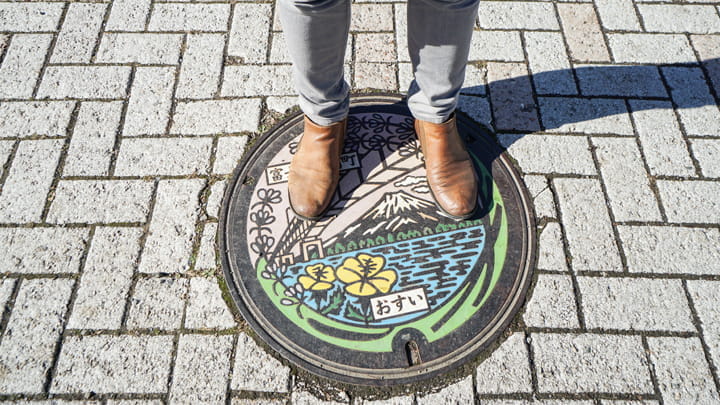Manhole cover arts makes sewage disposal fun!

For most people, it is hard to relate manholes to beauty and art. After all, unless your work is related to sewage or utility pipelines, you do not pay much attention to these spots through which wastewater and dirt pass. However, just as the French writer Victor Hugo says, “The sewer is the conscience of the city”. Having a sophisticated, well-designed sewer system is just as important as having majestic skyscrapers, for it enables us to live decently without worrying that our neighborhoods will be filled with disease-causing wastewater and garbage.
With that in mind, wouldn’t it be nice to add a little artistic touch to these "unpleasant" spots to make the neighborhoods where we live and work more enjoyable?
Japan's experience might be a good example from which to learn.
The Japan manhole cover art project started in the 1980’s when an official came up with the idea of decorating manhole covers with color paintings to get taxpayers' attention and win their approval for the renovation and maintenance of the under-funded public sewage systems. Citizens were originally hostile to the costly sewage renovation projects, as it had no doubt disturbed the peace in their neighborhoods with noisy, dusty construction activity.
This manhole cover art project was a huge success and eventually evolved into a national phenomenon. It has profoundly affected how people view sewage systems and brought continual attention to this industry by making so many eye-catching, culturally distinctive, and fun artworks ubiquitous and accessible to the public. This movement has certainly contributed to public support for the development of sewage systems and industry in Japan.
Currently, there are more than 15 million manhole covers in Japan that are decorated with colorful paintings. The designs of manholes in each city and prefecture differ from one another, but they all have one thing in common:
They are all pleasant and fun to look at!
You can see famous cartoon characters, such as Chibi Maruko-chan and the distinctive yellow mascot Pikachu from Pokémon, and tourist attractions like Mount Fuji and Osaka Castle. You can even walk into a crash course educating you on the Battle of Yashima, a famous historic event that happened a thousand years ago in Japan. Of course, iconic foods like Ramen and Sushi are popular choices too!
Designers have also used manhole covers to express their opinions. For example, one cover depicts Hello Kitty inviting hurried Tokyoites to ride through Tama City on a bike, a good way of calling for urbanites to pay more attention to their physical and mental health as well as for tourists to see more of the city. Another manhole cover in Tokorozawa shouts out the city’s ambition to become a carbon-neutral city by 2050.

Some local governments have taken additional steps to encourage the community to actively engage with these illustrated manhole covers. For example, some prefectures launched “drainspotting” cards for manhole hobbyists to collect. Many manhole cover enthusiasts travel to different locations across the country to find manhole covers to match their drainspotting cards with the designs and explanation on one side and the geographical coordinates to find them on the back. Once located, they post pictures of their “treasure hunting” activities on social media. You can even get souvenirs such as mugs, coasters, keychains, T-shirts and even snacks featuring different manhole designs.
Of course, these manhole covers are more than just eye candy. They can be functional and informative as well. For example, information is inscribed to identify the location of each manhole cover, making maintenance efficient and enabling prompt responses to residents' concerns. Manhole covers with blue rubber caps indicate that the cover can be opened to serve as an emergency toilet in times of disaster.
As the only visible parts of the underground sewage system, manholes play an important role in the city. They are often used as access points for underground sewage, drainage, and other public utility systems, allowing inspection, maintenance, and upgrades. For example, the trenchless pipe repairing method is performed through the manholes, which allows fast and clean repair to broken pipes without destruction of roads. Manhole covers prevent large, solid debris such as sand, paper, bottles, and plastic bags from entering the sewer pipes, thereby reducing the risk of sewer blockages and easing the burden on sewage treatment plants, which helps extend the service life of sewers. Foul gasses can escape from the sewer through manhole covers, which is essential for ensuring the safety of pipe workers. In addition, manholes align the pipelines to make sure their lengths remain consistent.
There is a reason why we bury the sewage pipes in the ground and make them as invisible as they can be, but Japan decided to bring up the “dirty issue” and make it visible to the public by making it fun, educational, and even engaging for everybody!
This movement has received wildly positive feedback for its beautification of the city, promotion of indigenous culture, boost to tourism and the economy, and, just as importantly, its appeal for public attention to the sewage system, which will in the long run attract more public funds to the improvement of the underlying infrastructure. For example, many prefectures had held manhole summits theming manhole cover designs and sewage management issues. One recent event was the 10th Manhole Summit held in Tokorozawa in Nov 2022, attracting more than 14,000 attendants. The event was themed COOL x COOL = Super COOL, which showcased manhole covers designed in conjunction with animation, traditional arts, and festivals. The summit organizer invited sewage management agencies and the Student Association of Water Science to give speeches related to the subject. Games and quizzes at the event also attracted many children and parents to engage. Of course, not to mention the long queue in front of the barbecue prepared in a manhole cover shaped pan!
For more information contact:
